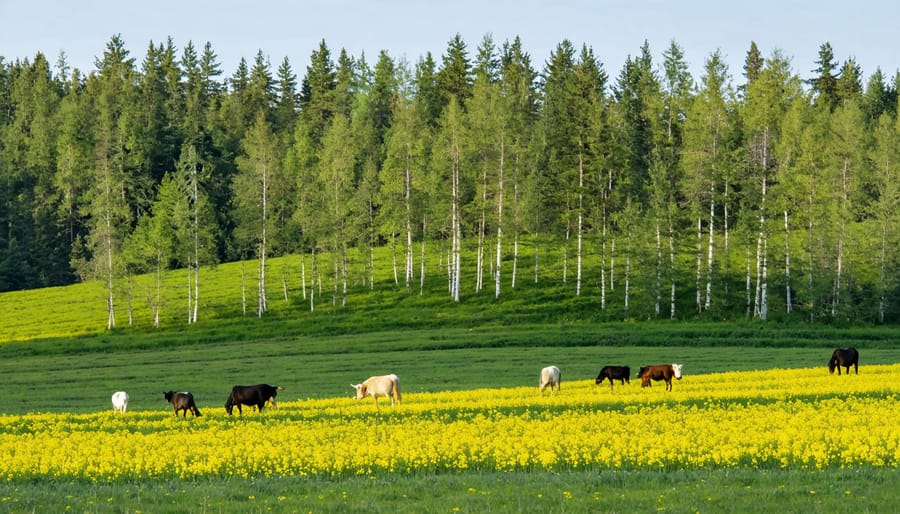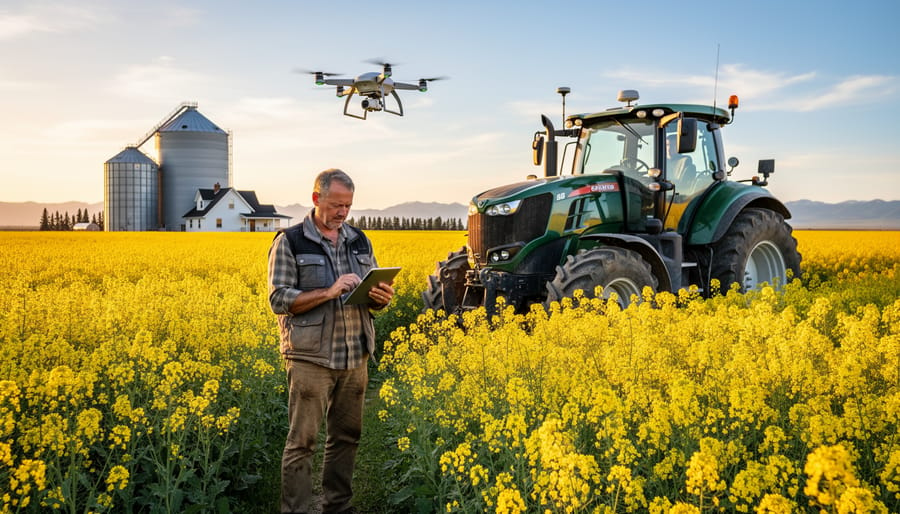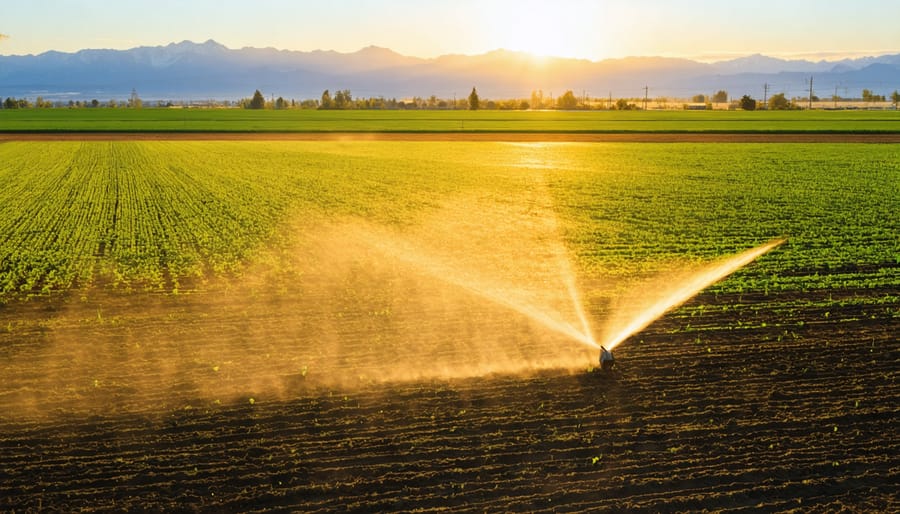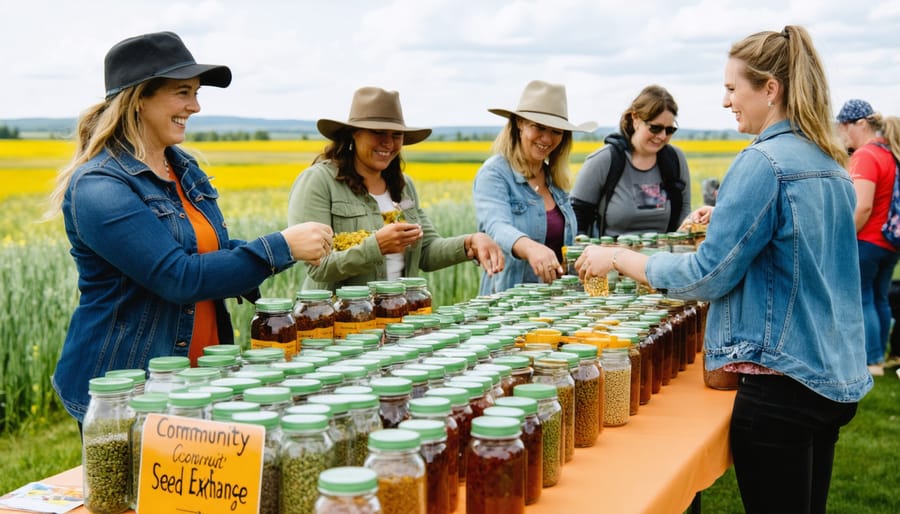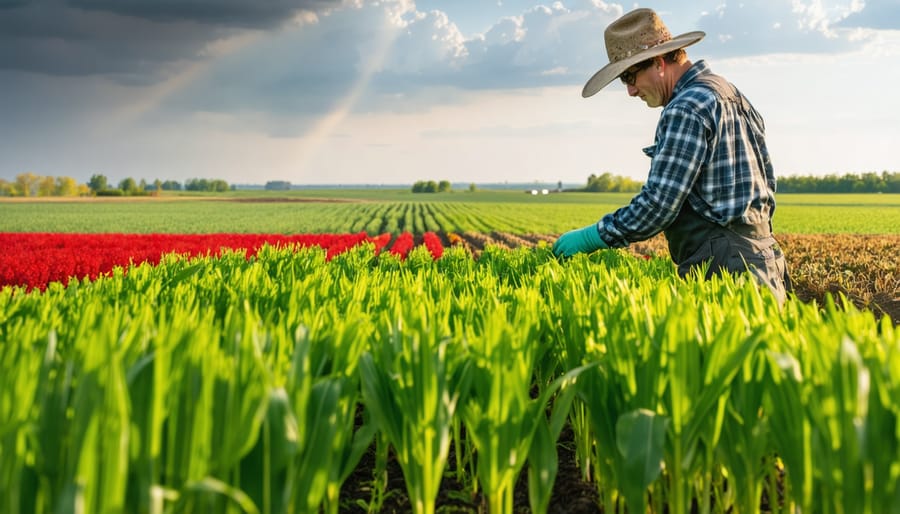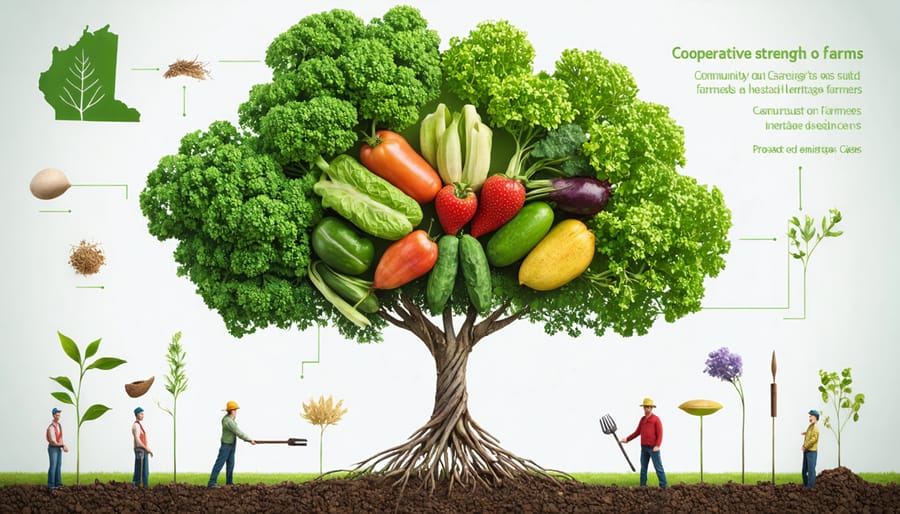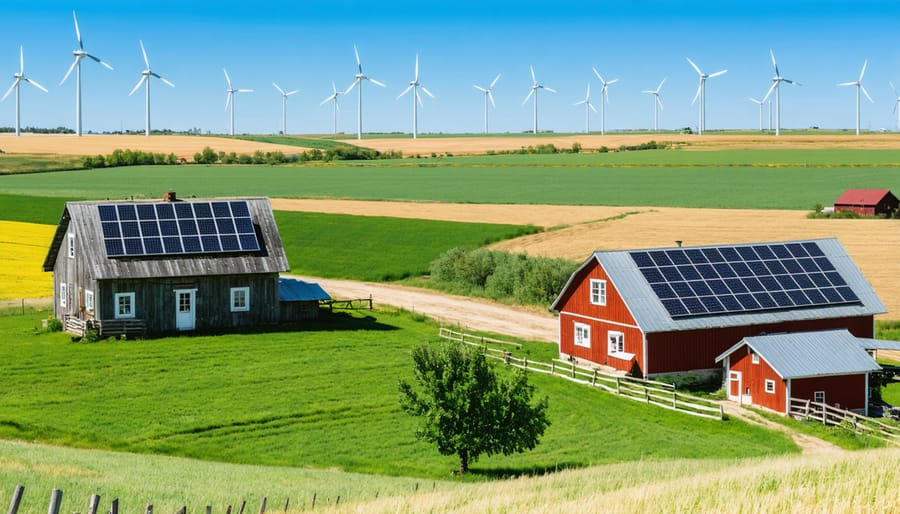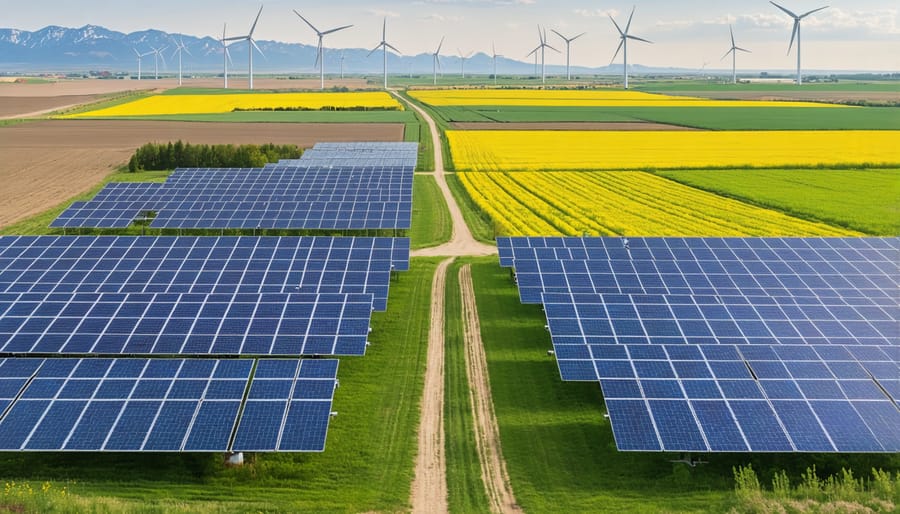Agroforestry stands as a beacon of hope in Canada’s agricultural landscape, combining traditional farming wisdom with modern sustainability practices. In Alberta’s diverse terrain, from the aspen parkland to the prairie grasslands, farmers are discovering how integrating trees and crops creates resilient, productive ecosystems that benefit both the land and their bottom line. This innovative approach to agriculture isn’t just about planting trees alongside crops—it’s a sophisticated system that maximizes land use while protecting soil health, enhancing biodiversity, and creating new revenue streams for farming communities.
Recent studies from the University of Alberta demonstrate that agroforestry systems can reduce soil erosion by up to 50% while increasing overall farm productivity by 40% compared to conventional monoculture practices. These systems prove particularly valuable in our northern climate, where windbreaks and shelter belts protect crops, improve water retention, and provide habitat for beneficial wildlife and pollinators.
As climate change poses increasing challenges to traditional farming methods, agroforestry emerges as a sustainable solution that not only adapts to environmental pressures but actively contributes to carbon sequestration and ecosystem health. For Canadian farmers seeking long-term sustainability, agroforestry offers a practical, profitable path forward that aligns with both environmental stewardship and economic viability.
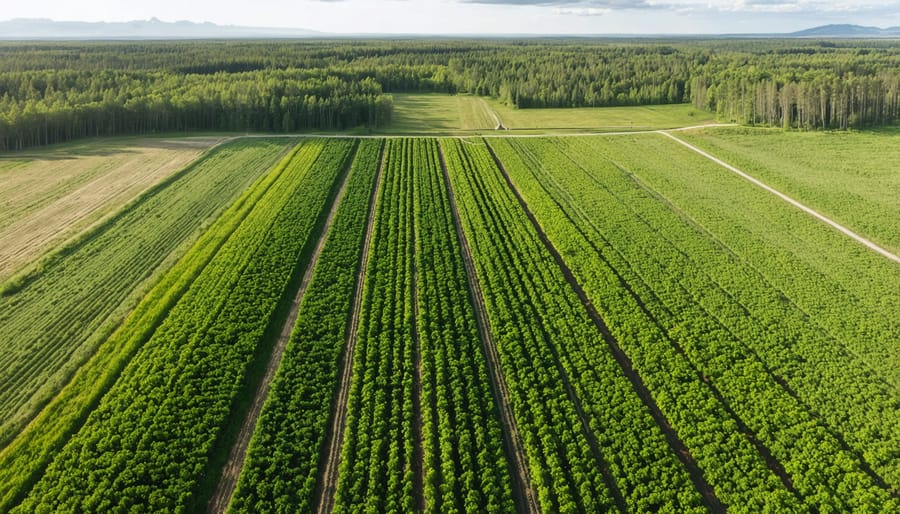
The Sustainability Framework of Community Agroforestry
Environmental Benefits
Agroforestry systems deliver remarkable environmental benefits that extend far beyond the farm gate. One of the most significant advantages is carbon sequestration, as trees and shrubs in these systems can store substantial amounts of carbon both above and below ground. In Alberta, studies show that a single hectare of agroforestry can sequester between 5 and 10 tonnes of carbon annually, helping offset agricultural emissions.
Biodiversity thrives in agroforestry systems, creating habitat corridors for native wildlife and beneficial insects. Local farmers report increased sightings of pollinators and birds, which contribute to natural pest control and improved crop yields. The diversity of plant species also provides year-round shelter for beneficial organisms that support ecosystem health.
Perhaps most importantly, agroforestry practices lead to significant soil health improvements. The deep root systems of trees and shrubs prevent erosion, increase organic matter content, and enhance water retention. This creates more resilient farming systems that can better withstand extreme weather events while reducing the need for synthetic inputs. Many Alberta farmers have noticed improved soil structure and increased earthworm activity within just a few years of implementation.
Economic Viability
The economic viability of agroforestry systems extends well beyond traditional single-crop farming models. Alberta farmers are increasingly discovering paths to sustainable profit through agroforestry by diversifying their income streams across multiple seasons.
A well-designed agroforestry system typically generates revenue through various channels: timber and wood products, fruits and nuts, specialty crops like mushrooms, and even eco-tourism opportunities. Many Alberta farmers report that while initial setup costs can be higher than conventional farming, the long-term financial benefits often outweigh the investment within 5-7 years.
For example, the integration of shelterbelts has shown to improve crop yields by 15-20% through wind protection and enhanced moisture retention, while simultaneously producing marketable wood products. Additionally, the presence of trees and diverse plantings creates opportunities for value-added products like maple syrup, medicinal herbs, and honey production.
Risk mitigation is another significant economic advantage, as diversified systems are more resilient to market fluctuations and extreme weather events. When one crop faces challenges, others can help maintain steady income flow.
Success Stories: Alberta’s Community Agroforestry Projects
The Red Deer Valley Project
Located in central Alberta, the Red Deer Valley Project stands as a shining example of community-supported agroforestry success. Launched in 2015, this initiative has transformed 120 hectares of conventional farmland into a thriving integrated system combining traditional crops with native tree species.
The project incorporates rows of white spruce and trembling aspen between strips of wheat, canola, and barley. After just five years, participating farmers reported a 15% increase in soil organic matter and a significant reduction in wind erosion. The tree rows also serve as natural snow fences, improving moisture retention and reducing irrigation needs by approximately 20%.
What makes this project particularly noteworthy is its collaborative approach. Fifteen local farming families share resources, knowledge, and equipment, making the transition to agroforestry more economically feasible for all participants. The community has established a mentorship program where experienced agroforesters guide newcomers through their first years of implementation.
The economic benefits have been substantial, with participating farms reporting an average 25% increase in total farm revenue through diversified income streams, including timber products and increased crop yields. The project has also created new opportunities for local honey production and wild berry harvesting, demonstrating how agroforestry can strengthen both environmental sustainability and community resilience.
Indigenous Knowledge Integration
Indigenous communities across Canada have long practiced sophisticated agricultural methods that harmonize with natural ecosystems. Today, modern agroforestry systems are being enriched by incorporating traditional Indigenous farming practices that have sustained communities for generations. In Alberta, farmers are learning valuable lessons from Indigenous knowledge-keepers about companion planting, sustainable harvesting, and the strategic use of native species.
The Three Sisters method – interplanting corn, beans, and squash – exemplifies Indigenous wisdom in action. This technique naturally enhances soil fertility, maximizes space usage, and creates beneficial microclimates. Many Alberta farmers have adapted this principle to include local varieties and native plants that thrive in our climate.
Indigenous knowledge also emphasizes the importance of forest edge ecosystems, where different plant communities meet. These transition zones, rich in biodiversity, inspire modern silvopasture designs that maximize both timber and livestock production while maintaining ecological balance.
Local Indigenous communities share insights about harvesting periods, weather patterns, and plant interactions that have been refined over centuries. This knowledge, when combined with modern scientific understanding, creates robust and resilient agroforestry systems that are uniquely adapted to our regional conditions.
By acknowledging and incorporating Indigenous wisdom, Canadian farmers are developing more sustainable and productive agroforestry systems that respect both traditional knowledge and contemporary agricultural needs.
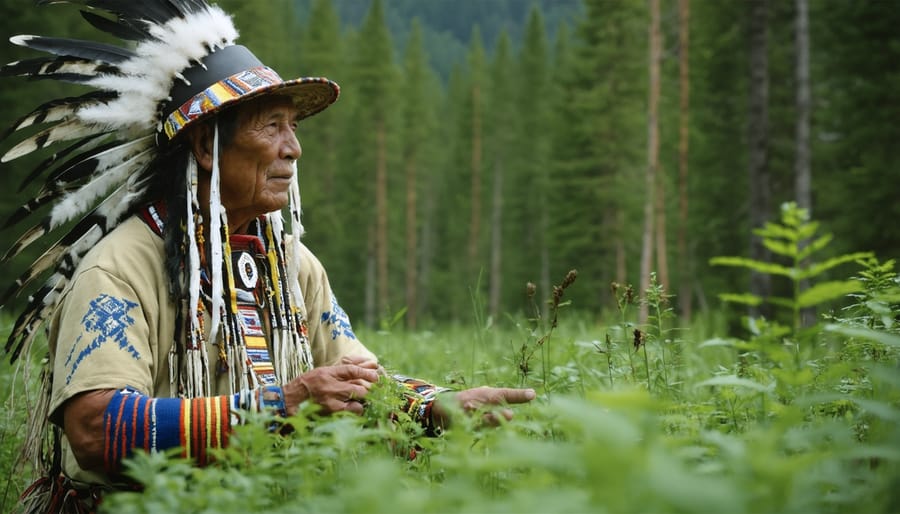
Overcoming Implementation Challenges
Climate Adaptation Strategies
Alberta’s unique climate presents distinct challenges for agroforestry systems, but innovative adaptation strategies have proven successful across the province. Farmers have developed effective methods to protect trees and crops from extreme temperature fluctuations, particularly during the harsh winter months and late spring frosts.
Wind management plays a crucial role in Alberta’s agroforestry success. Strategic placement of shelterbelts using hardy species like caragana and green ash helps reduce wind erosion and creates beneficial microclimates for more sensitive crops. These windbreaks also serve as natural snow traps, providing essential moisture for spring growth.
Moisture conservation techniques are essential in Alberta’s semi-arid regions. Mulching with organic materials helps retain soil moisture and regulate soil temperature. Many farmers implement drip irrigation systems specifically designed for tree-crop combinations, maximizing water efficiency while supporting both components of the system.
Species selection is particularly important for climate resilience. Native species like saskatoon berries and chokecherries have proven especially successful, as they’re naturally adapted to local conditions. For non-native species, careful consideration of hardiness zones and frost tolerance is crucial.
Monitoring and adaptive management practices help farmers respond to changing conditions. Regular soil testing, weather tracking, and adjusting planting schedules based on local climate patterns ensure optimal growth and survival rates for both trees and crops.
Community Engagement Solutions
Building lasting community engagement in agroforestry projects requires a thoughtful, collaborative approach. In Alberta, successful initiatives often start with forming local steering committees that include farmers, Indigenous knowledge holders, and agricultural experts. These committees help ensure projects reflect community needs and cultural values.
Regular workshops and field days have proven effective in maintaining interest and knowledge sharing. The County of Grande Prairie, for example, hosts quarterly gatherings where farmers can exchange experiences and learn new techniques. These events typically see participation rates of 70% or higher among project members.
Establishing mentorship programs connects experienced agroforesters with newcomers, creating valuable knowledge transfer networks. Several Alberta communities have implemented “buddy systems” where veteran practitioners guide those just starting their agroforestry journey.
Digital platforms also play a crucial role. Online forums and social media groups specific to Canadian agroforestry help maintain year-round engagement, especially during winter months when field activities are limited. These platforms allow farmers to share success stories, troubleshoot challenges, and coordinate resource sharing.
Financial incentive programs, like those offered through various agricultural cooperatives, help sustain long-term participation by offsetting initial implementation costs and rewarding sustainable practices. This combination of social connection, practical support, and economic benefits creates a robust framework for ongoing community involvement.
Getting Started with Community Agroforestry
Planning Your Project
Before diving into agroforestry, careful planning is essential for long-term success. Start by assessing your land’s characteristics, including soil type, drainage patterns, and existing vegetation. Consider conducting a soil test through Alberta Agriculture Services to understand your baseline conditions.
Map out your available space and identify areas where trees can complement existing operations without hindering equipment access. A typical Alberta quarter section can accommodate various configurations, from shelterbelts to alley cropping systems.
Set clear objectives for your agroforestry project. Are you focusing on wind protection, soil improvement, or creating additional income streams? Your goals will influence species selection and planting patterns. Consider native species like trembling aspen or white spruce, which are well-adapted to our climate.
Connect with local agricultural extension offices and experienced agroforesters in your region. The Alberta Agroforestry Network offers valuable mentorship opportunities and can help you avoid common pitfalls. Create a realistic timeline that accounts for seasonal conditions and available resources.
Develop a budget that includes initial costs like seedlings, protection materials, and irrigation systems. Research available grants and funding programs through provincial agricultural initiatives. Remember to factor in long-term maintenance requirements and potential revenue streams when planning your investment.
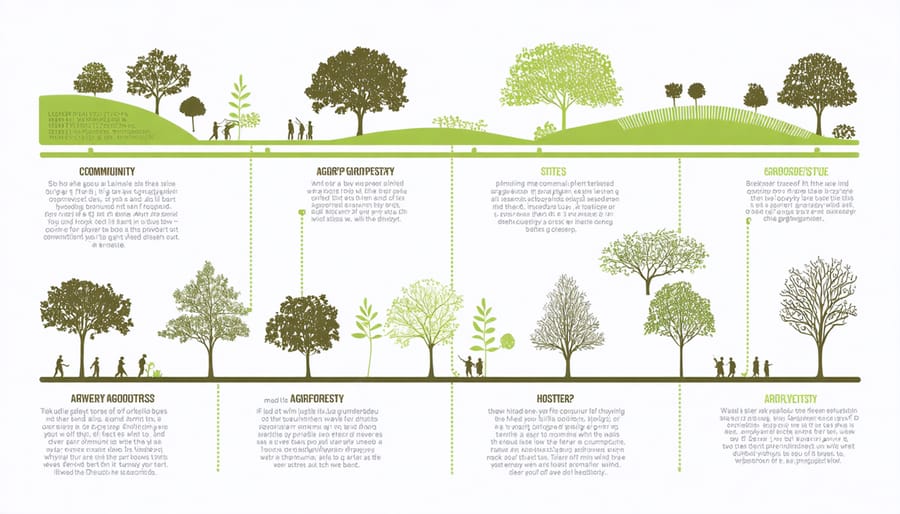
Available Resources and Support
Alberta farmers interested in implementing agroforestry practices can access numerous support systems and resources. The Agroforestry and Woodlot Extension Society (AWES) offers comprehensive technical assistance, including site assessments, design consultations, and ongoing support throughout project implementation.
Financial assistance is available through various programs, including the Canadian Agricultural Partnership (CAP), which provides funding for sustainable agriculture initiatives. The Environmental Farm Plan (EFP) program offers cost-sharing opportunities for implementing agroforestry systems, with funding covering up to 70% of eligible expenses.
Local agricultural fieldmen and extension specialists provide free consultations and can connect farmers with relevant expertise. The University of Alberta’s Faculty of Agricultural, Life & Environmental Sciences offers workshops and training programs specifically designed for agroforestry practitioners.
The Alberta Woodlot Extension Program maintains a network of demonstration sites where farmers can observe successful agroforestry systems firsthand. Regular field days and workshops at these sites provide valuable hands-on learning experiences.
For ongoing support, the Alberta Agroforestry Network facilitates peer-to-peer learning and mentorship opportunities. Their online resource library includes practical guides, case studies, and research papers specific to Alberta’s growing conditions and climate challenges.
The evidence is clear: agroforestry stands as a beacon of sustainable agriculture in Canada, offering multiple environmental, economic, and social benefits. From improved soil health and biodiversity to enhanced farm resilience and diversified income streams, agroforestry systems have proven their worth across Alberta’s diverse landscapes.
As we’ve seen through successful local implementations, these systems can be adapted to various scales and contexts, whether you’re managing a large farm operation or working with a community project. The key to sustainability lies in the system’s ability to balance ecological preservation with profitable agricultural production – a balance that many Alberta farmers have already achieved.
The path forward requires collective action and commitment. For those considering agroforestry, start small and scale gradually. Connect with local agricultural extension services, join farmer networks, and learn from experienced practitioners in your region. The Alberta Agroforestry Network and various regional agricultural societies offer valuable resources and support for getting started.
Remember that sustainability isn’t just about environmental protection – it’s about creating resilient farming systems that support our communities for generations to come. By embracing agroforestry practices, we’re not only investing in our land’s future but also strengthening our local food systems and rural economies.
Take the first step today. Whether it’s planting a windbreak, establishing a silvopasture system, or joining a local agroforestry initiative, your actions contribute to a more sustainable agricultural future for Alberta and beyond.

